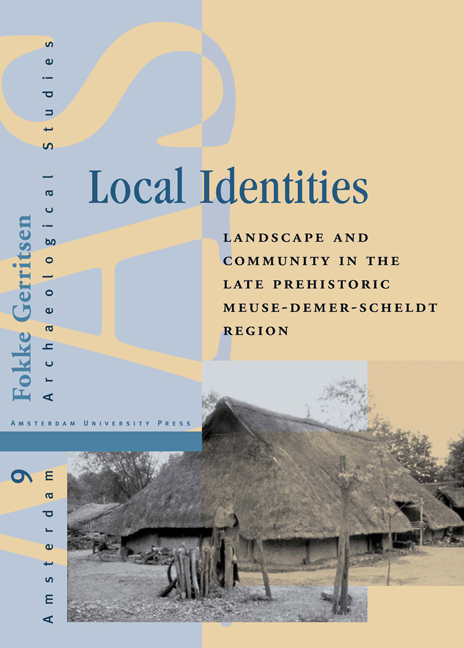Book contents
- Frontmatter
- Contents
- Acknowledgment
- 1 Introduction
- 2 Archaeology in a Sandy ‘Essen’ Landscape
- 3 The House and its Inhabitants
- 4 Local Communities and the Organisation of the Landscape
- 5 Micro-Regional and Regional Patterns of Habitation, Demography and land use
- 6 Landscape, Identity and Community in the First Millennium BC
- Abbreviations
- References
- Appendix 1 Meuse-Demer-Scheldt Region. Distribution of Urnfields
- Appendix 2 Catalogus of Urnfields
- Index of Geographical Names
6 - Landscape, Identity and Community in the First Millennium BC
Published online by Cambridge University Press: 28 January 2021
- Frontmatter
- Contents
- Acknowledgment
- 1 Introduction
- 2 Archaeology in a Sandy ‘Essen’ Landscape
- 3 The House and its Inhabitants
- 4 Local Communities and the Organisation of the Landscape
- 5 Micro-Regional and Regional Patterns of Habitation, Demography and land use
- 6 Landscape, Identity and Community in the First Millennium BC
- Abbreviations
- References
- Appendix 1 Meuse-Demer-Scheldt Region. Distribution of Urnfields
- Appendix 2 Catalogus of Urnfields
- Index of Geographical Names
Summary
In this chapter I wish to return to the main themes that have been explored in this study: landscape, the construction of local social identities, and the distribution and representation of claims to land. In several ways it is intended as a synthesis. In the preceding chapters, an analytical separation was made between several social levels and between spatial scales.The house and household were treated in relative isolation from the local community and settlement territory, and local communities were not viewed in relation to each other until the chapter on micro-regional habitation and land use patterns. It could be argued that these distinctions were to some extent also meaningful in the past, as different social groups were shown to define themselves through different means and on different geographical scales.The aim of this chapter, however, is to focus on the interaction between social levels and their differentiated relationships with land and landscape.
Another artificial separation was made between social and cultural dimensions on the one hand and ecological and economic possibilities and constraints on the other. While chapters 3 and 4 placed a stronger emphasis on the former, the focus in chapter 5 was mostly on subsistence economy, demographic trends and ecological change. This has been a useful analytical distinction for the sake of argumentation and clarity, but it has little to do with real life. In the introduction I argued for a theoretical perspective that is sufficiently sensitive to the need to look at how people in the past actively interpreted and ordered the world around them, but that does not disregard the influence that ecological stimuli may have had in instigating social and cultural change. Up to this point in this study I have made few systematic attempts at combining them.While not claiming to overcome dichotomies between material and ideological or between nature and culture, I will attempt in this synthesis to identify the interplay between the different dimensions of human interaction with the landscape.
In order to keep this synthesis to a manageable size, I will largely work from the interpretations and conclusions reached earlier, without repeating in full the arguments that underlie them.Where appropriate, I refer to the relevant sections in the preceding chapters.
- Type
- Chapter
- Information
- Local IdentitiesLandscape and Community in the Late Prehistoric Meuse-Demer-Scheldt Region, pp. 235 - 254Publisher: Amsterdam University PressPrint publication year: 2003



